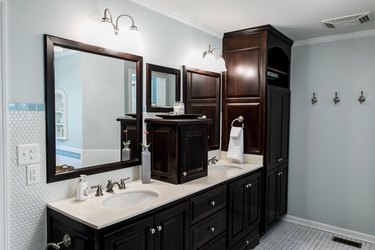
Whether you're going for a full-on bathroom remodel or simply want to replace your vanity, making sure you have the right size is absolutely key. Not only will this ensure your vanity fits in the designated area, but it can also help you choose the vanity that best suits your particular needs. Knowing how to measure a vanity will help ensure you make the right choice.
Exterior Vanity Dimensions
Video of the Day
You can use a tape measure to get the general dimensions of your bathroom vanity. Take a measurement at the widest part of the variety in contact with the the floor, which is your base width. Then, measure across the countertop, which is your top width.
Video of the Day
Next, to get the depth dimensions of your vanity, take base and top measurements. To get the base measurement, you may need to remove a drawer and reach inside the vanity toward the back. Finally, you need to take the height measurement.
Standard Vanity Sizes
Most bathroom vanities are within a range of standard sizes. The smallest vanity options measure between 24 and 30 inches in width. On the larger end of the spectrum, vanities with double sinks are at least 60 inches wide.
The standard depth of bathroom vanities is 21 inches, while most bathroom vanity designs are between 31 and 32 inches high. However, if you require a more specific size, you can design a custom-fitted bathroom vanity of (almost) any size.
Single vs. Double
If you have enough space and share your bathroom, it can be a good idea to go for a double vanity rather than just a larger single one. They can make use of a shared bathroom far easier plus offer more in the way of storage and counter space. A double vanity could also increase the value of your home in the future.
However, double vanities can be more expensive to install and to maintain. Some homeowners also find that two sinks are unnecessary and not the best use of counter space.
Backsplash and Mirror
When trying to fit a bathroom vanity, there are other factors you need to consider besides exterior dimensions. Along with the space your bathroom vanity takes up, there must also be space allocated for the backsplash, mirror and bathroom cabinet.
The area behind your sink isn't just a practical consideration — it's also an opportunity to add some personal flair to your vanity. Ensuring there's space on the wall behind your proposed vanity area for some tiles, a mirror or some extra storage can be key to a more practical and aesthetically appealing vanity.
Several Additional Considerations
To get the most functional bathroom vanity size for you, you'll also want to think about sink size. The bigger the sink, the smaller the amount of counter space.
Another important consideration when measuring for your perfect bathroom vanity is plumbing lines. Vanity sinks need to have access to the water mains, which can be a huge consideration when designing your bathroom overall. Corner vanities, for example, can be a perfect use of space in a smaller bathroom, but they can be difficult to install, depending on the location of existing water and drain lines.
When thinking about your bathroom vanity, it's also important to think about the layout of your bathroom overall. You want to make sure you have enough walking space plus room to properly open drawers and cupboards. It may be worth checking out the ADA requirements for bathroom vanities to help make sure yours is as accessible as possible.